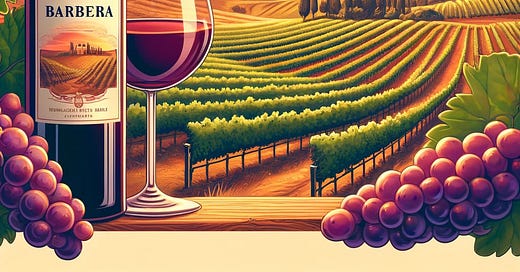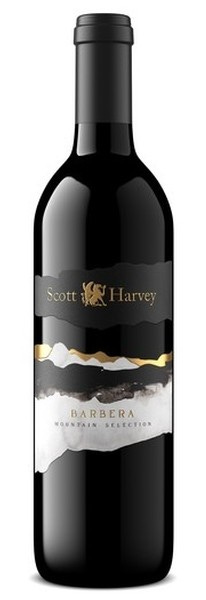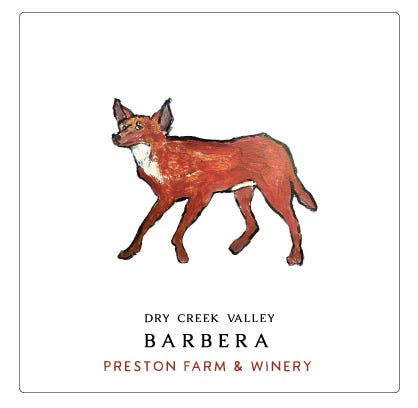NAPA VALLEY, Calif. — Most Americans who seek a sound, food-friendly dry red wine that can be purchased for a reasonable price normally choose cabernet or merlot because they are so widely available. But good ones can be pricey. And since zinfandel can often be a little alcoholic, and Chianti is rarely reliable because styles change from producer to producer, and many other reds are equally confusing, my go-to choice for a tasty food companion often is barbera.
Barbera, along with sangiovese, are two of the Italian grape wines that work best with tomato-y dishes, pizza and other rustic fare. And they represent two of the largest plantings of grapes throughout Italy. Both varieties grow with equal abandon, both deliver wines that have excellent acidity and both make wines that have the ability to deliver beautiful flavors with five to seven more years after the bottling date.
However, it is a bit easier to make barbera into a fine wine because sangiovese tends to ripen unevenly, leaving inexperienced producers in a quandary. If sangiovese is harvested too late, the wine doesn’t really display as much personality as it ought to. And if picked too early, the wine can be uninterestingly acidic and not particularly pleasing.
For a tasty food companion, my go-to choice is often barbera, a wine that delivers beautiful flavors and excellent acidity.
For that reason, I usually prefer barbera, especially if I know that the producer has done an exemplary job attempting to capture the special qualities that it can deliver. And people who know wine probably will agree with me: barbera often can be an incredibly special wine with a berry personality that’s easy to love with food.
One more thing: it doesn’t require a steep learning curve. Lovers of dry red wine usually adore barbera because it’s a little bit more interesting than typically over-ripe zinfandel, and it has quite an appeal that makes it the simplest choice when beef is being served.
One major difference between the two grapes is that barbera (bar-BEAR-uh) has far less astringency than does sangiovese, which makes it a little less aggressive in the mouth and not as tannic. So, it must be structured based on its acid for it to work nicely with food. Which almost all of them do.
Another characteristic of this lovely grape is the wide range of styles in which it may be found, with some of them displaying darker colors that are purple-ish and others offering a much lighter color, but often with just as much flavor.
Even though it is widely planted in many areas of Italy, the grape’s Italian homeland is in the cooler north, particularly in Piemonte and most notably outside the town of Asti, where it often is referred to as barbera d’Asti. There, it makes a lighter, more elegant wine, although some producers can make dark and concentrated wines as well.
The Italian wine called barbera d’Alba comes from a district nearer to where nebbiolo grows and produces Italy’s most famous red wine, the expensive and long-lived barolo. As a result, barbera d’Alba can be richer and more opulent, but the best vineyard sites near Alba are often planted to nebbiolo to make barolo. So, fewer bottes of barbera d’Alba are made, which usually makes them expensive. As a result, a lot of barbera d’Asti can be found at very fair prices, between $20 and $30.
To get the best quality barbera d’Asti, knowledgeable lovers of Italian wines seek out the barberas that are designated Nizza. Barbera d’Asti Superiore Nizza DOCG was certified in 2008 by Italian wine authorities as a super-premium designation in Piemonte. Today those wines sell at premium prices and Italophiles often buy them as soon as they hit shelves.
In 1990, I toured one of Piemonte’s smallest sub-districts, an area known as Monferrato. There I visited the late producer Giacomo Bologna at his home. His Braida winery still makes two spectacular vineyard-designated barbera wines on facing hills just outside the tiny town of Rocchetta Tanaro. Decades ago, both wines were imported into the United States and sold to knowledgeable buyers for high prices. But few Americans knew of the wines’ quality and after a few years when they didn’t sell particularly well, they stopped being imported. I haven’t seen a bottle of Braida in this country in 25 years.
Although barbera makes a lovely wine in California’s north coast, it’s not as widely planted here because other grapes make more popular wines. One of the oldest North Coast plantings of barbera is at Greg Graziano’s Mendocino County ranch in Redwood Valley.
About his 70-year-old barbera ranch, Graziano’s website says, “Once known as a peasant wine, this grape has grown to be one of the most widely planted varietals in the Piemonte region of northwestern Italy. Today, Barbera is one of the most exalted grapes of this rugged mountain region. It arrived in California with Italian immigrants in the 19th century and it adapted well to the coastal volcanic soils. When it is produced from low yields and treated to barrel aging, it can make extremely exciting wines. This represents our 25th vintage of Barbera.” Graziano’s 2018 barbera sells for $35.
The largest barbera plantings in California are in the Sierra Foothills, notably in Amador County, where it seems to flourish in one of the state’s most underrated fine-wine regions. It is there that a barbera festival is held each year. This year the Amador Vintners Association will celebrate National Barbera Day with the Barbera Festival 2024 on Aug. 3 starting at 4 p.m. It will feature extensive barbera tastings, gourmet food and live music. The event is extremely popular and tickets frequently sell out well in advance. Purchase tickets online.
Two of the top barbera producers in the state are both in Amador County, Jeff Runquist and Scott Harvey.
Of Runquist’s 2022 Amador County Barbera ($30), his site says the wine “has a ruby purple color with a moderate depth. The aroma centers on raspberry, cherry, and current, along with a perfumed note of violets and lavender. The aromas are framed with notes of vanilla, nutmeg, and hazelnut (which) generates a gravitational pull that is hard to resist.” He refers to the additional acidity in this wine, which makes it so much more appealing with food than several other grapes.
Of Harvey’s 2021 Mountain Selection Barbera, Amador County ($35), his site says, “Grown on steep mountainous terrain in the higher elevations of the Shenandoah Valley of Amador County, the wine has dark color, red fruit of currents, white pepper, violets, oregano, coffee, and grilled steak leading to an extractive fleshy structure with firm tannins and a long lingering finish.”
Another excellent Foothills wine is 2018 Boeger Barbera, El Dorado County ($21). “A variety of clones grown on vineyards between 2,000 and 3,000 feet are used to make up our Barbera, creating a perfect representation of El Dorado County Barbera. Mouth-wateringly aromatic, this wine jumps out of the glass with luscious red fruit aromas. Soft and full on the palate, it is a pleasure to drink on its own, but its inherent acidity also makes it a perfect accompaniment to most dishes.”
In Sonoma County’s Dry Creek Valley, Preston Farm and Winery also produces an excellent barbera, but its 2021 vintage is sold out.
As good as California barberas can be, and they can be superb, the most authentic versions are from northern Italy. In a new book entitled “Italy’s Native Wine Grape Terroirs,” author Ian D’Agata says, “Barbera d’Asti offers something for everyone… When it is good, Barbera d’Asti is simply a great wine, and it is exactly what I reach for when I want to drink an effusively fruity, cheerful, juicy red.”
Napa Valley Features Insights (not from Dan Berger, but from our editors): Finding a barbera in Napa Valley can be a challenge, yet the Gaudi-Carli Barbera from Robert Biale Vineyards is exceptional. This $55 wine showcases a vibrant nose with notes of Bing cherry, rhubarb, plum, Iris, cinnamon and root beer, coupled with a palate of earthy cassis, blackberry and porcini mushroom balanced by fresh acidity. Produced in limited quantities in Calistoga, it often sells out quickly.
If today's story captured your interest, explore these related articles:
Dan Berger has been writing about wine since 1975.









